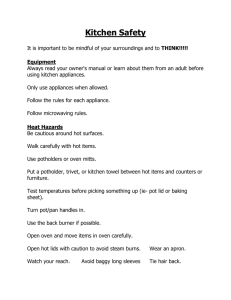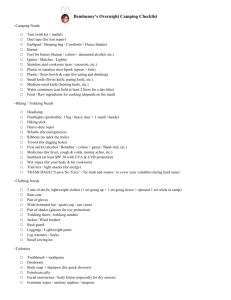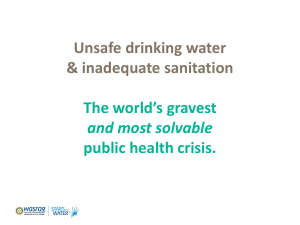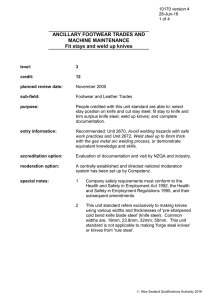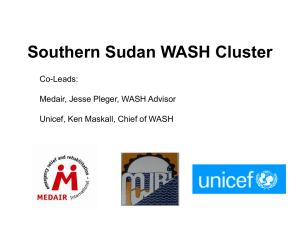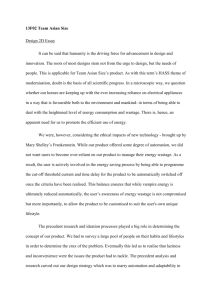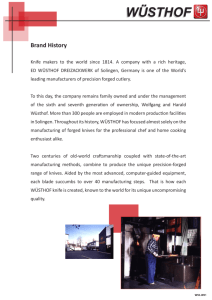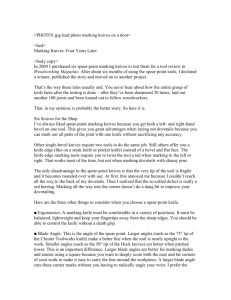KEY HUM-FNW Unit 2 Study Guide
advertisement
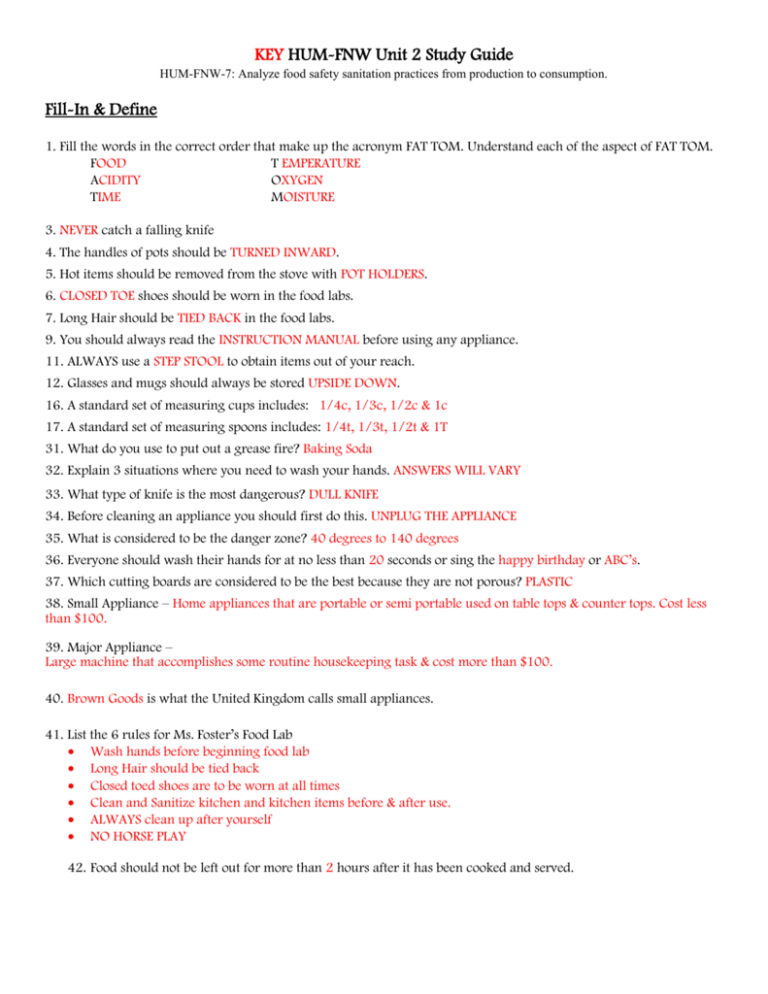
KEY HUM-FNW Unit 2 Study Guide HUM-FNW-7: Analyze food safety sanitation practices from production to consumption. Fill-In & Define 1. Fill the words in the correct order that make up the acronym FAT TOM. Understand each of the aspect of FAT TOM. FOOD T EMPERATURE ACIDITY OXYGEN TIME MOISTURE 3. NEVER catch a falling knife 4. The handles of pots should be TURNED INWARD. 5. Hot items should be removed from the stove with POT HOLDERS. 6. CLOSED TOE shoes should be worn in the food labs. 7. Long Hair should be TIED BACK in the food labs. 9. You should always read the INSTRUCTION MANUAL before using any appliance. 11. ALWAYS use a STEP STOOL to obtain items out of your reach. 12. Glasses and mugs should always be stored UPSIDE DOWN. 16. A standard set of measuring cups includes: 1/4c, 1/3c, 1/2c & 1c 17. A standard set of measuring spoons includes: 1/4t, 1/3t, 1/2t & 1T 31. What do you use to put out a grease fire? Baking Soda 32. Explain 3 situations where you need to wash your hands. ANSWERS WILL VARY 33. What type of knife is the most dangerous? DULL KNIFE 34. Before cleaning an appliance you should first do this. UNPLUG THE APPLIANCE 35. What is considered to be the danger zone? 40 degrees to 140 degrees 36. Everyone should wash their hands for at no less than 20 seconds or sing the happy birthday or ABC’s. 37. Which cutting boards are considered to be the best because they are not porous? PLASTIC 38. Small Appliance – Home appliances that are portable or semi portable used on table tops & counter tops. Cost less than $100. 39. Major Appliance – Large machine that accomplishes some routine housekeeping task & cost more than $100. 40. Brown Goods is what the United Kingdom calls small appliances. 41. List the 6 rules for Ms. Foster’s Food Lab Wash hands before beginning food lab Long Hair should be tied back Closed toed shoes are to be worn at all times Clean and Sanitize kitchen and kitchen items before & after use. ALWAYS clean up after yourself NO HORSE PLAY 42. Food should not be left out for more than 2 hours after it has been cooked and served. KEY HUM-FNW Unit 2 Study Guide HUM-FNW-7: Analyze food safety sanitation practices from production to consumption. 43. List the temperatures for the following foods… a. Beef, Lamb and Veal 1. Ground meats - 160 2. Roast, Chops & Steaks: 3. Medium Rare 145 4. Medium Well 160 5. Well Done 170 b. Poultry - 165 c. Pork: All Cuts of Ground Meats: 1. Medium 160 2. Well done 170 3. Fresh Ham 160 4. Fully Cooked Ham 140 d. Eggs: Eggs and Eggs Dishes 160 e. Leftovers (reheated) 165 44. What are the storage times (days) for the following leftovers? Cooked beef, pork and poultry 3-4 days Sushi eat day purchased Casseroles 3-4 days Pizza & Cooked Egg Dishes 3-4 days Sliced Deli Meats 3-5 days Cooked Vegetables 3-4 days Hard-Boiled Eggs 7 days Cakes/Cheesecakes 7 days Name the Following Kitchen Items 42. Jelly Roll KEY HUM-FNW Unit 2 Study Guide HUM-FNW-7: Analyze food safety sanitation practices from production to consumption. 43. Cookie Sheet 44. Spring form pan 45. Wisk 46. Egg Separator 47. Garlic Press 48. Stock Pot KEY HUM-FNW Unit 2 Study Guide HUM-FNW-7: Analyze food safety sanitation practices from production to consumption. 49. Dutch Oven 50. Double Boiler 51. Pastry Blender 52. Pizza Pan 53. Cooling rack * Know the parts of a knife as well as the different types of knives. 54. The shape you hold your hand in when using proper slicing techniques is called the Bear Claw. 55. What type of steel will not rust? Stainless Steel. 56. What are the two types of steel used for knives? Carbon Steel & Stainless Steel 57. All knives have teeth. 58. Explain the proper way to wash a knife. Blade down, and by themselves in a sink that will not dull the knife. 59. Explain what HACCP stands for and what it is. Hazard Analysis Critical Control Point. HACCP is a management system in which food safety is addressed through the analysis and control of biological, chemical, and physical hazards from raw material production, procurement and handling, to manufacturing, distribution and consumption of the finished product. KEY HUM-FNW Unit 2 Study Guide HUM-FNW-7: Analyze food safety sanitation practices from production to consumption. 60. Who created HACCP and for who? Pillsbury Corporation for NASA astronauts in space. 61. Explain the difference between acidity and alkalinity in foods. Acidity: Foods with a pH below 7 are acidic Alkalinity: Foods with a pH higher than 7 are alkaline Neutral: a pH of 7 62. The lower the pH, higher the acidity. 63. The higher the pH the lower the acidity. 64. Explain the difference between aerobic and anaerobic. Aerobic: Microorganisms that need air to grow. Anaerobic: the absence of air (some microorganisms will grow without air).
